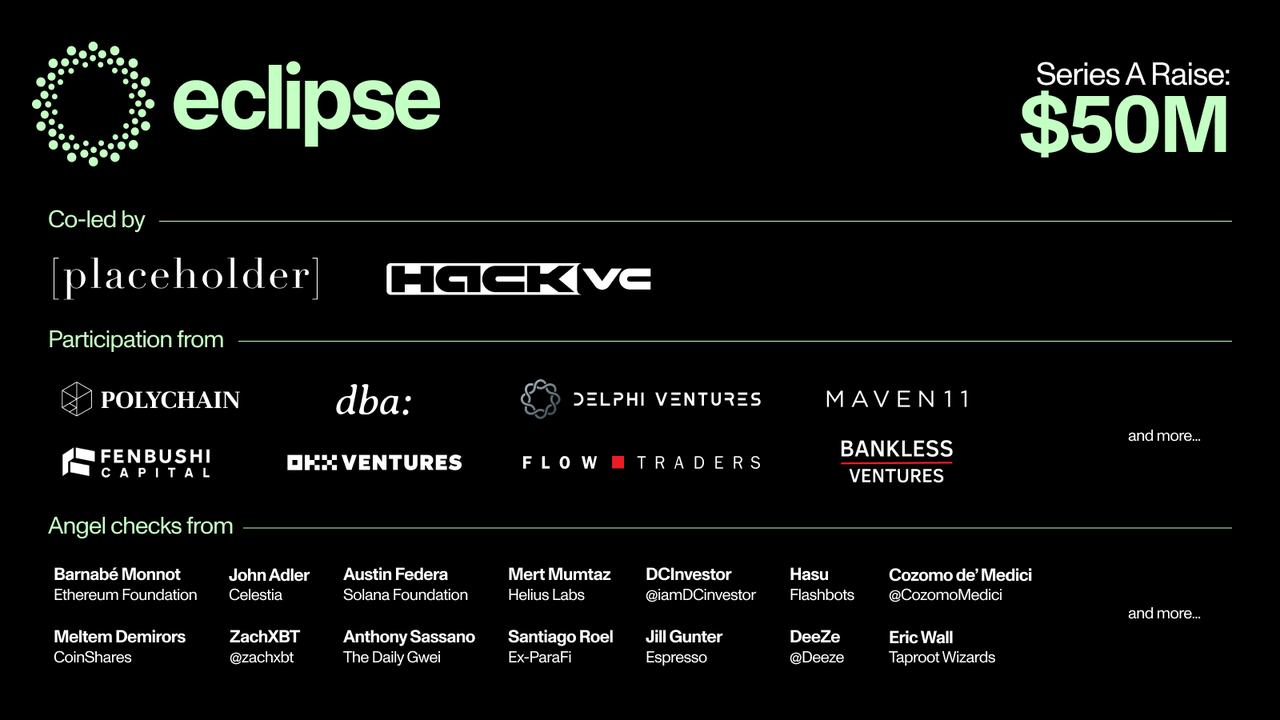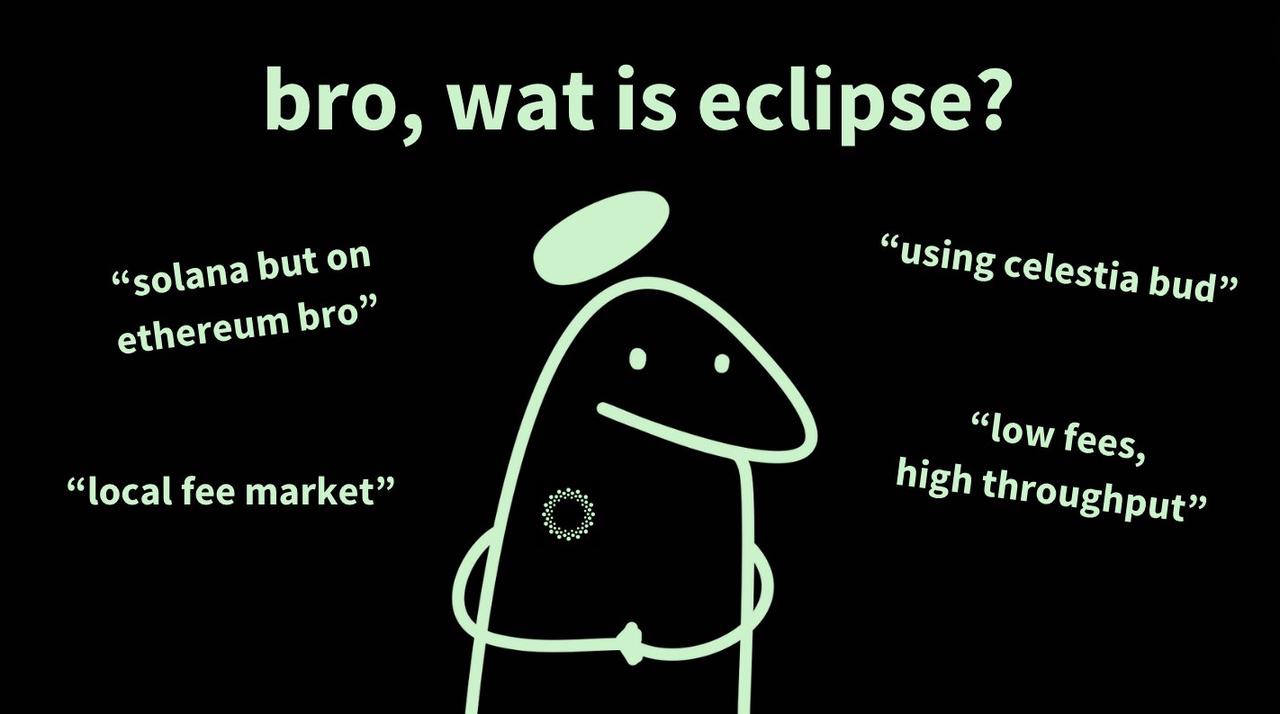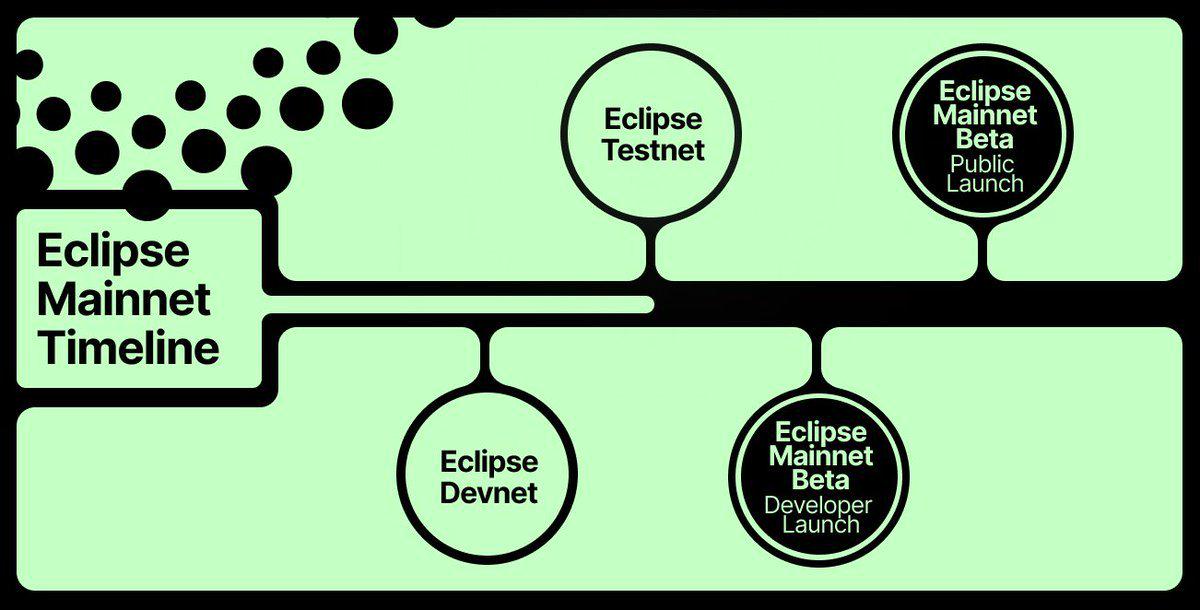On March 11, 2024, Eclipse Labs announced the completion of a $50 million Series A financing round, led by Placeholder and Hack VC. In 2022, Eclipse had already completed a $15 million pre-seed and seed round of financing, valuing the company at over a billion dollars. The project's total funding has now reached $65 million.

It is reported that Eclipse is committed to creating a Rollup platform with core advantages aimed at improving the compatibility, security, and scalability of blockchain technology. The following introduces the Eclipse project.
Core Purpose of Eclipse: Building a Stronger Layer2 Solution through Solana Virtual Machine (SVM) Performance
The recent announcement of the Eclipse Mainnet project by Eclipse Labs marks a new phase of innovation in blockchain technology. This platform adopts a multidimensional fusion technology architecture, cleverly combining the robust security of Ethereum, the outstanding performance of Solana, and advanced data availability (DA) technologies such as Celestia. Its core purpose is to build the fastest and most adaptable Layer 2 solution on the market through the powerful execution of the Solana Virtual Machine (SVM). This is not just a convergence of technologies, but also reflects Eclipse's high regard for openness and customizability.
As a Rollup solution, Eclipse's emergence provides a new perspective on blockchain interoperability and customization. The platform supports compatibility with multiple Layer 1 blockchains, providing unprecedented freedom for developers. They can now freely choose and customize various components from the execution environment (such as EVM, SVM, MoveVM, etc.) to the data availability layer (such as Celestia, Polygon Avail, EigenDA, etc.) based on individual or project needs. This open and flexible design not only allows Eclipse to adapt to various data availability requirements but also enables these different layers to share Eclipse's settlement layer, further enhancing the integration and efficiency of the technology.
The settlement layer of Eclipse plays a unique role in its architecture. It relies on Celestia for sovereign aggregation, focusing on bridging and transmitting proofs without directly participating in executing any smart contracts. This innovative "settlement aggregation" model delegates all execution operations to independent execution chains, ensuring efficient transaction processing and laying the foundation for the platform's scalability and flexibility.

Through this design, Eclipse Mainnet is not only a product of technological innovation but also an extension of the application prospects of blockchain technology. It demonstrates how integration and customization of technology can address existing challenges, improve transaction efficiency, reduce costs, and ultimately enable more widespread deployment of decentralized applications (DApps). As Eclipse continues to develop and improve, it may become a key force driving innovation and widespread application of blockchain technology.
The launch of Eclipse Mainnet not only showcases the strength and innovation of the Eclipse Labs technical team but also proves to the entire blockchain community that system performance and adaptability can be effectively enhanced through technological integration and customized design. In the future, as more developers and projects choose Eclipse as their technical platform, we have reason to believe that Eclipse will play an increasingly important role in the application and development of blockchain technology, ushering in a new wave of technological revolution.
Overly Binding with Terra in the Early Stage Led to Continuous Controversies, How is Eclipse Slowly Emerging from the Industry's Shadow?
In October 2022, a major news in the blockchain industry attracted widespread attention: former Terra ecosystem developer Neel Somani successfully raised $15 million for his new project, Eclipse. This marked an important turning point, not only in Somani's career but also as a significant contribution to the entire Solana ecosystem. Eclipse, as a Solana-based cross-chain modular Rollup startup, demonstrates the spirit of learning from failure and moving forward.
After the failure of his project Terranova in the Terra ecosystem, Somani was not discouraged. Instead, he gained valuable experience, especially regarding the importance of avoiding single points of failure, and based on these experiences, built a protocol that could flexibly exchange its Layer 1 components. This innovative thinking attracted widespread market attention and successfully attracted support from investors, including Solana co-founder Anatoly Yakovenko.
In the summer's pre-seed financing round, Eclipse raised $6 million from investors including Yakovenko and Polygon. This successful financing round was followed by a $9 million seed round led by Tribe Capital and Tabiya. Somani sees this financing achievement as the crystallization of his past experiences, especially his deep understanding of how to build a more robust and reliable blockchain solution.
Somani's background is equally impressive. As a former quantitative analyst at Citadel, his career in crypto engineering initially started as a part-time job. During the development of TerraNova, he envisioned the possibility of using the Solana Virtual Machine to explore "some way, shape, or form to make it its own chain." When the Terra project collapsed, Somani did not stop but continued forward, leveraging his established network and the geographical advantage of being near Solana's headquarters in Chicago to create Eclipse.
While achieving significant success in investor support, Somani and his team members, including Chief Growth Officer Vijay Chetty, Engineering Director David Lin, and Chief of Staff Kayla Bu, are committed to further developing Eclipse. According to Somani, Eclipse plans to open source its first protocol version early next year, indicating that its technology and innovation may have a profound impact on the entire blockchain ecosystem.
At the same time, some prominent figures in the Terra ecosystem are facing legal challenges, including the recent arrest of the former head of TerraForm Labs in South Korea (although the arrest warrant was subsequently rejected). Against this backdrop, Somani and Eclipse's story provide an inspiring example, demonstrating that even in the face of adversity, new development paths can be opened through innovation and perseverance.
The Mainnet Will Go Live in Q2, Can Eclipse Bridge the Trillion-Dollar Value Circulation between Solana and Ethereum?
With the announcement of strategic investment in Eclipse by OKX Ventures, Eclipse, the first Ethereum Layer 2 solution running in the Solana Virtual Machine (SVM) environment, is facing new opportunities for transformation and growth. This investment not only signifies the maturity of Eclipse's technology but also indicates that its foundational technology support for providing fast, secure, and flexible Web3 application interaction needs will be further strengthened.
Eclipse's modular components allow developers to customize development in diverse execution environments such as EVM, SVM, and MoveVM, and combine efficient data settlement in data availability (DA) layers such as Celestia, Polygon Avail, and EigenDA. This flexibility not only creates a developer-friendly development environment but also ensures that end users can enjoy the safest and most economical interaction experience, thanks to Eclipse's adoption of efficient and secure ZK fraud proof technology RISC Zero.

The news that Eclipse is about to launch its mainnet in the second quarter of this year further deepens expectations for its technical strength and market potential. With the successful launch of the testnet, Eclipse has already rewarded the first developers to deploy contracts on the platform with commemorative NFTs, which not only motivates community participation but also demonstrates Eclipse's commitment to driving high-quality DApp development.
However, the challenges facing Eclipse should not be overlooked. With the release of its mainnet architecture, Eclipse will need to find a balance in technical upgrades, ecosystem expansion, and market fluctuations. Especially in the increasingly competitive crypto market, how to continue providing innovative solutions while ensuring platform stability and security will be an important issue for Eclipse to address.
Token unlocking events and upcoming market dynamics will also bring new liquidity challenges to Eclipse. How to absorb newly unlocked tokens without affecting price stability will be a test of Eclipse's market resilience.
Overall, Eclipse stands at the forefront of Web3 development, with both potential and challenges. As technology continues to advance and the ecosystem expands, Eclipse's role in the cryptocurrency field is becoming increasingly prominent. For investors and users, this is a critical moment to closely monitor and evaluate Eclipse's long-term development potential.
免责声明:本文章仅代表作者个人观点,不代表本平台的立场和观点。本文章仅供信息分享,不构成对任何人的任何投资建议。用户与作者之间的任何争议,与本平台无关。如网页中刊载的文章或图片涉及侵权,请提供相关的权利证明和身份证明发送邮件到support@aicoin.com,本平台相关工作人员将会进行核查。




